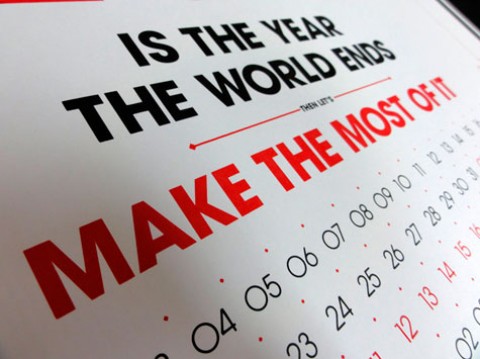
“The only people for me are the mad ones, the ones who are mad to live, mad to talk, mad to be saved, desirous of everything at the same time, the ones who never yawn or say a commonplace thing, but burn, burn, burn like fabulous yellow roman candles exploding like spiders across the stars…” Jack Kerouac, On the Road
Let Me Reveal A Secret
As a creative person, you are the most important person in your company.
You may have suspected it, but you’ve always been told that the list is ten times as important as the creative; and nothing will ever be accomplished without the account people; and of course, it’s the production managers who really get the job done.
It’s all true, of course, but I still insist that the creative people are the most important part of the entire process.
There are people who can critique your work, improve your work, suggest ways to change your work, evaluate your work, and even build on your work. But as one great writer said to his critics, “Where the hell were you when the paper was blank?”
It’s a fact that nothing happens without the creative people.
In most agencies, there are probably 10 of them for every one of you. But without you, and your ideas, the agency grinds to a halt.
David Ogilvy once said, “Here are two ads for the same product. They are the same size. They cost the same. But one was read by 31 times as many prospects as the other.
“What would you think if the media buyer in your agency could buy 31 times as much circulation per dollar as other media buyers? You would think they were the most important person in the agency business.
“That is exactly the position you creative people are in. It is within your power to get 31 times as many people per dollar to notice and read and respond to your ad.”
Then why don’t creative people get the respect we deserve? There’s a simple explanation …
Nobody Understands You
They may be amused by you. They may envy you. They may even want to be just like you. But they just don’t understand how in the world you do it.
They see you with your feet up on our desk, or maybe not even at a desk, and they wonder, “What are they really doing?”
The answer is, of course, you’re thinking.
And they say, “But they shouldn’t be thinking, they should be working.”
The world doesn’t understand creative thinkers, for two reasons. First, most of the world doesn’t think.
George Bernard Shaw said, “Most people never think at all. I have made an international reputation for myself by thinking once or twice a week.”
And the second reason why the world doesn’t understand you is that I’m not really sure you understand you. How do you come up with ideas? They just come, don’t they?
How do you know if they’re any good? You just know … and you kind of have to make it up as you go along. You don’t follow a formula. You don’t have a secret recipe like Coca-Cola.
You face new challenges and have to come up with fresh solutions every day. And you’re probably just as mystified by it as everyone else.
Someone asked Steven King, “How do you come up with ideas?” The horror writer was horrified – “How do you not come up with ideas?”
Unfortunately, if you put most people inside a room and ask them to come up with three good ideas before they come out, they will starve to death. But that’s something creative people have to do every single day, and often not three ideas, but 23.
It’s almost like magic. Which reminds me of a wonderful poem by Shel Silverstein:
“Sandra’s seen a leprechaun,
Eddie touched a troll,
Laurie danced with witches once,
Charlie found some goblins gold.
Donald’s heard a mermaid sing,
Susie spied an elf,
But all the magic I have known
I’ve had to make myself.”
And that’s the goal of my presentation – to give you some of the tools I’ve found useful to make your own magic. Let me start by telling you a story.
What Are Your Rocks?
A man comes on stage with an empty jar. He then fills it with large rocks. “Is the jar full?” he asks. Everyone agrees that it is.
He shakes his head, and then fills up the spaces with tiny pebbles. “Is the jar full now?” he asks. Everyone agrees that it is.
He then begins to pour sand into the jar, and asks, “How about now?” Everyone thinks that yes, now the jar is full. And then he pours in water … and finally the jar really is full.
What’s the point of the story? If I told it to a group of account people, they would say, “You can always squeeze something else in!” But as a creative person, I’m sure you’ve guessed the real point of the story.
If you don’t put the rocks in first, you’ll never have room for them. If you don’t put the big things in your life in first, you’ll never have room for them. The rest of your time will fill up, with small things insignificant things, petty things. You don’t have to worry about them … they’ll come. But it is absolutely essential to make room for the big things.
So what are the big things you need to put in your jar in order to make the most of your creativity? I have five suggestions.
#1: No Fear
It takes courage to come up with an idea; to share it with others; to risk being foolish; or risk someone not liking it. As a creative person, you have to put it on the line every single day.
Politicians run for re-election every few years. Teachers renew their contracts every year or so. But you have to produce – and not just the same old stuff – but brand new stuff, all the time.
And you thrive on that, don’t you? In fact, it’s probably that challenge that you most enjoy. Let me share a story about creativity and courage.
A long time ago, a famous Rabbi used to travel from town to town and give a lecture on the Bible. One day, just as they were coming to the outskirts of a town, the driver turned around to the teacher and said, “You know, everywhere we go, people treat you so well. They put you up in the best house, they prepare the finest foods for you, and me, a simple driver, I have to sleep in the barn.”
“Just once,” the driver said, “I’d like to change places with you.”
“What about the speech?” the Rabbi asked.
“I’ve heard you give it so many times, I know it by heart,” said the driver.
“But what if anyone has any questions?” the Rabbi persisted.
“Let me worry about that,” assured the driver.
And so they switched clothes, the driver got in the back, and the Rabbi drove them into town. The driver gave the speech brilliantly, and the Rabbi listened happily in the back.
But, as he got to the end, the Rabbi began to worry – what would happen if anyone asked a question? The driver knew the speech, but really couldn’t answer any questions about the Bible.
Sure enough, right after the driver finished, the crowd applauded and one man held up his hand. “I have a difficult question,” the man said, and proceeded to ask an incredibly complex question about the Bible and the origin of sin and the laws.
The driver took it all in, and then said, “You call that a difficult question? That’s so easy, even my driver could answer that.”
The more risk, the more rewards.
When a London agency pitched the British Railway account, they invited the client into the agency for a presentation. The clients arrived on time, and were told that the agency was running a little late, and would they mind waiting?
The British Railway people sat down to wait, but then they looked around them. The seats were very uncomfortable. Some of them even had springs coming out. There were cigarette butts and crumbled paper on the floor. It didn’t look like a successful advertising agency.
After 15 minutes, the clients were furious. They said, “What kind of agency keeps us waiting for such a long time, and in such a dirty and unpleasant room?” At that point, the president of the agency came out and said, “Mr. Jones, that’s exactly how people feel about British Railways!”
They got the account.
Creativity takes courage. And it’s important to remember that courage isn’t the lack of fear, it is the overcoming of fear. As the great painter, Georgia O’Keeffe said, “I’ve been absolutely terrified every moment of my life, and I’ve never let it keep me from doing a single thing that I wanted to do.”
#2: Adopt Your Inner Child
A friend of mine gives private art lessons. Her five-year-old daughter once asked her, “What are you doing?”
She said, “I’m teaching Mrs. Fisher to draw.”
Her daughter looked up in amazement, “Did she forget?”
If you’re a creative person, you are essentially doing the same things you did as a kid. You learn stuff, you draw or write, you use your hands a lot, sometimes you get pretty messy. The only difference is today you get paid for them.
As Picasso said, “Every child is an artist. The problem is to remain an artist after you grow up.”
How do you do that? You remain a child. You keep your eyes open. You try to figure things out, and see patterns. You look at things from a different perspective. You try to do the opposite of what everyone else is doing.
You ask why, a lot. You don’t take yourself too seriously. You can take your job seriously, and your work seriously, but never yourself. As G.K. Chesterton said, “Angels fly because they take themselves lightly.”
Let me tell you the silliest thing I ever did in a client meeting. I wore a full gorilla suit. The client was Edgar’s department stores, and we were presenting a campaign called “Anything can Happen.”
So I rented a gorilla suit, took my briefcase, and strolled casually into the client meeting. I presented my work without a word of explanation.
The client didn’t notice a thing, or so it seemed. Until I finally broke down, and said, “Come on Carol! Aren’t you going to say anything?”
She looked me straight in the eye and said, “You didn’t shave this morning.”
My next rock is one that you’re really going to appreciate.
#3: Be Good To Yourself
Creative people are usually very good to themselves – they deserve it.
That’s why they usually have candy in their drawers and toys on their desks. That’s why they have better stereos, and more CD’s, and drive better cars, and take more interesting vacations.
Sometimes it’s not what you do, but when you do it. For example, have you ever gone to the movies in the middle of the day? Worked out when you should be working? Had dessert before, or instead of, the meal?
These are all things that help put you in touch with your creative spirit. And so will answering this question:
“In the past 12 months, I rewarded myself by buying or doing [ ].”
What have you done to reward yourself for your hard work, or to celebrate your successes?
My answer is that I bought a Jeep Wrangler with a top that comes off. It’s not often warm enough to take the top off. It’s also not the safest car. And it only seats two. And I don’t do any off-road driving.
But do you know something? I think it makes me look really cool.
Part of rewarding yourself is making sure you have enough fuel. Great ideas come from books, music, paintings, art exhibits, museums, cartoons, crossword puzzles, movies, experiences, other people.
They come from going to the circus, and taking classes and attending lectures and conferences, and traveling to places you’ve never been, and going back to places that meant a great deal to you.
It’s like putting stuff up on a shelf, in your mind, that you can draw from when you need it. And the more stuff, the more likely you are to find something you can use.
So make sure you make time to do the things that inspire you, whatever they might be.
That leads me my fourth rock.
#4. Remember that you are absolutely, totally, completely unique … just like everyone else.
You bring your own unique experiences and perspective to every project. Your ideas can really come from nobody else but you. And you need to recognize and appreciate your uniqueness.
In one of my speeches, I asked creative people to answer the following question:
“I think that I am the only person in this room who [ ].”
The answers were just amazing, and we spent 20 minutes sharing our experiences.
One woman had attended three Beatles recording sessions. Another had lunch with Richard Gere, and turned him down. A man had written a top 40’s song. And I never would have found out any of that, unless I had asked.
Ordinary people are afraid of being unique, of being different, of standing out. Most creative people thrive on that.
#5. Never forget you’re a creative person.
You may think you’re just a copywriter, but you probably spend more time thinking than writing. And your best ideas are probably visual ones. And you’re not just describing things, you’re inventing things. And you probably don’t know a lot about writing, anyway.
You may think you’re just an art director, but you’re probably not the one who does the actual illustrations or takes the photographs. And you probably come up with better headlines than the writers do. And you probably spend more time on your computer than your accountant does.
So you’re not just an ordinary person – you’re creative. And even Albert Einstein said, “Imagination is more important than knowledge.”
In Nelson Mandela’s 1994 inaugural speech, he shared this remarkable thought:
“Our deepest fear is not that we are inadequate. Our deepest fear is that we are powerful beyond measure. It is our light, not our darkness that most frightens us. Your playing small does not serve the world. There’s nothing enlightened about shrinking so that other people won’t feel insecure around you.
“And, as we let our light shine, we unconsciously give other people permission to do the same. As we are liberated from our own fear, our presence automatically liberates others …”
So go for it.
———-
Copyright 2012 Alan Rosenspan & Associates. This article reprinted with permission.
Alan Rosenspan is the president of Alan Rosenspan & Associates, a direct marketing creative and consulting firm. Alan and his teams have won over 100 awards for creativity and results, including 19 DMA Echo Awards. Alan developed the Creative Strategy course for the Direct Marketing Association, and was a direct marketing instructor at Bentley College for 11 years.










